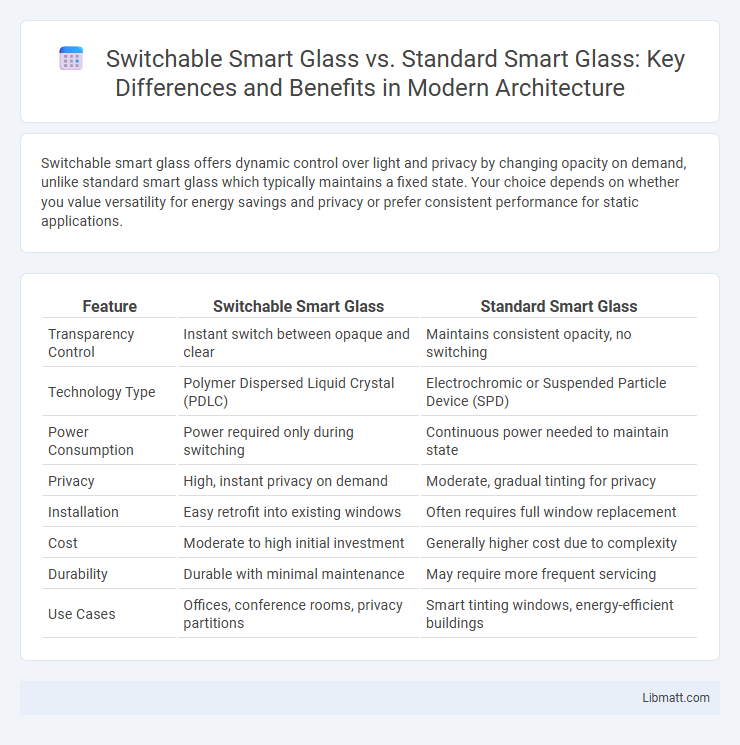Switchable smart glass offers dynamic control over light and privacy by changing opacity on demand, unlike standard smart glass which typically maintains a fixed state. Your choice depends on whether you value versatility for energy savings and privacy or prefer consistent performance for static applications.
Table of Comparison
| Feature | Switchable Smart Glass | Standard Smart Glass |
|---|---|---|
| Transparency Control | Instant switch between opaque and clear | Maintains consistent opacity, no switching |
| Technology Type | Polymer Dispersed Liquid Crystal (PDLC) | Electrochromic or Suspended Particle Device (SPD) |
| Power Consumption | Power required only during switching | Continuous power needed to maintain state |
| Privacy | High, instant privacy on demand | Moderate, gradual tinting for privacy |
| Installation | Easy retrofit into existing windows | Often requires full window replacement |
| Cost | Moderate to high initial investment | Generally higher cost due to complexity |
| Durability | Durable with minimal maintenance | May require more frequent servicing |
| Use Cases | Offices, conference rooms, privacy partitions | Smart tinting windows, energy-efficient buildings |
Introduction to Smart Glass Technologies
Smart glass technologies include switchable and standard smart glass, both designed to control light transmission and enhance energy efficiency. Switchable smart glass allows users to toggle between transparent and opaque states, providing dynamic privacy and glare control, whereas standard smart glass typically offers fixed light modulation. Understanding these differences helps you choose the right solution for your architectural or automotive needs.
What is Switchable Smart Glass?
Switchable smart glass, also known as privacy glass, uses liquid crystal technology or electrochromic materials to change from transparent to opaque on demand, providing instant privacy and light control. Standard smart glass typically offers fixed tint levels or gradual shading but lacks the rapid, reversible opacity shift that switchable smart glass provides. Your choice between switchable and standard smart glass depends on the need for dynamic privacy and energy efficiency in various settings like offices, homes, or automotive applications.
Understanding Standard Smart Glass
Standard smart glass typically utilizes electrochromic or liquid crystal technology to control light transmission and privacy by switching between opaque and transparent states. It operates by applying an electrical voltage that alters the material's optical properties, enabling instant privacy without blocking natural light. This technology enhances energy efficiency and glare reduction in various architectural and automotive applications.
Key Differences Between Switchable and Standard Smart Glass
Switchable smart glass offers dynamic control over opacity, allowing you to change transparency with a simple switch or remote, enhancing privacy and energy efficiency. Standard smart glass typically maintains a fixed level of opacity or tint, lacking the ability to adapt in real-time to varying light conditions. Key differences include adaptability, user control, and application flexibility, making switchable smart glass ideal for versatile environments where instant privacy and glare reduction are essential.
Energy Efficiency Comparison
Switchable smart glass offers superior energy efficiency compared to standard smart glass by dynamically adjusting transparency to control solar heat gain and light transmission, reducing reliance on HVAC systems and lighting. Its ability to adapt to changing environmental conditions helps lower overall energy consumption in buildings. You can achieve significant energy savings and improved thermal comfort by choosing switchable smart glass over traditional static smart glass solutions.
Privacy and Light Control Features
Switchable smart glass offers superior privacy by instantly changing from transparent to opaque with a simple electrical switch, providing you with customizable control over visibility. Unlike standard smart glass, which primarily focuses on light diffusion without full opacity, switchable glass enhances light control by allowing precise adjustment between natural light penetration and complete blackout. These advanced privacy and light control features make switchable smart glass ideal for environments where both discretion and ambient lighting are critical.
Installation and Maintenance Considerations
Switchable smart glass typically requires more complex installation due to integrated electrical wiring and control systems, whereas standard smart glass involves simpler mounting without electrical components. Maintenance for switchable smart glass includes regular inspection of electrical connections and software updates to ensure optimal performance, contrasting with standard smart glass that mainly requires routine cleaning and minimal upkeep. The added complexity of switchable smart glass can lead to higher long-term maintenance costs compared to standard smart glass solutions.
Cost Analysis: Switchable vs. Standard Smart Glass
Switchable smart glass typically incurs higher upfront costs compared to standard smart glass due to advanced materials and technology integration. However, your long-term savings on energy efficiency and personalized opacity control can offset the initial investment. Standard smart glass often provides a more budget-friendly option but may lack the dynamic performance and versatility of switchable variants.
Popular Applications and Use Cases
Switchable smart glass is widely used in commercial offices, healthcare facilities, and high-end residential projects for privacy control and energy efficiency, enabling dynamic light modulation and enhanced user comfort. Standard smart glass finds popular applications in automotive windows, retail displays, and conference rooms, primarily offering static privacy and glare reduction without real-time adjustability. Both technologies cater to different market needs with switchable smart glass excelling in interactive environments and standard smart glass suited for cost-effective, fixed solutions.
Which Smart Glass Solution Is Right for You?
Switchable smart glass offers dynamic opacity control, allowing users to adjust transparency instantly for privacy and energy efficiency, which is ideal for offices, healthcare, and residential spaces requiring versatile light management. Standard smart glass typically provides fixed properties such as frosted or tinted finishes, suitable for applications where consistent privacy or glare reduction is needed without interactive features. Choosing between the two depends on your need for real-time customization versus cost-effectiveness and specific environmental controls.
Switchable smart glass vs standard smart glass Infographic

 libmatt.com
libmatt.com